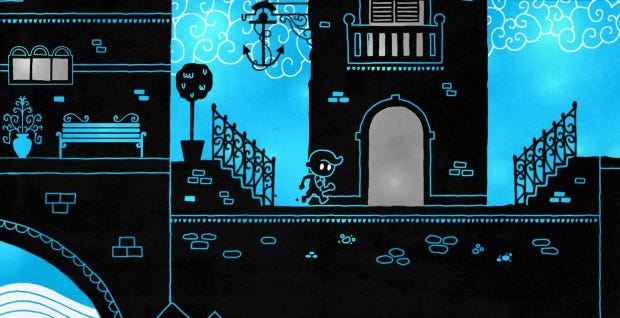Wot I Think: Hue
A colour-swapping puzzle platformer.
Your mother invented colour, and then accidentally disappeared. Bit of a faux pas in the science community, but one that sets you off on Hue’s colourful, doodley, puzzle adventure. Here's wot I think.
You play the titular Hue (so named because your mother was a hippy, presumably) who finds his mother’s Annular Spectrum (titter) and discovers that it can summon colour to a world which was previously greyscale. It’s not long before you find out that this new colour wheel of yours can be used to solve puzzles. By changing the colour of the 2D background to the same as an object or obstacle before you, you can effectively make that object disappear and reappear at will.
This is the core (and pretty much only) concept behind Hue, but it’s the level design that makes it worth coming back to again and again. Starting simple with your standard “push block, climb on block” fare, Hue warms you up by adding colours one-by-one to your colour wheel until you feel competent enough to take on some of its incredibly tricky levels.
Along with the new colours come new ideas and objects: coloured lasers that will kill you in one hit unless you change the background; slime that recolours an object; springs that change colour every time you bounce on them. Combining and experimenting with these new playthings is required to master them, as each level has just one solution, and the further you progress the more confusing and complex the solution will be. While playing, I’ve seen friends desperately posting screenshots on Twitter in search of a solution. You don’t get that with most games.
The difficulty curve gets pretty steep in the last hour or so of the game, which is pretty standard for a puzzle-platformer but it might lead to you cursing like a sailor as even the larger and longer levels have no checkpointing. If you’ve completed 15 steps perfectly and everything is all in place but you realise that you forgot to turn one specific block into a different colour right at the start, you’ll have to throw yourself into the path of a laser or down into some spikes to start over, which seems a little tonally inconsistent for a game that’s about a cute kid trying to find his mother.
It's not the only way that Hue's tone can be a little off at times. An appealingly chunky, doodley style and the bright, vivid colours of the background and the objects implies something cute and light-hearted, but Hue wants be more like To The Moon - a deep and thoughtful narrative.
This is achieved with letters scattered around the levels, which are full of philosophical, wistful writings from your accidentally-invisible mother. She tells the story of the Annular Spectrum and how it was stolen and scattered across the land in between anecdotes about her and this guy she met (the one who stole and scattered the thing). It’s a little bit weird at times hearing your mother talk about how she may or may not have banged this scientist this one time, but hey, being trapped in the invisible part of the spectrum probably loosens your tongue a little.
Along with that is a very plaintive piano soundtrack, which is what most reminds me of To The Moon. It’s lovely, but a little jarring - not quite background enough to be unnoticeably nice; not quite fitting with the tone of the levels.
But all of that is just window-dressing for what is a genuine and pleasant experience. When you get the colour-switching concept down to a T and you’re flicking between shades like a picky interior designer going through sofa swatches, it feels fluid and fun. There are puzzles which will leave you feeling stuck and frustrated, but Hue encourages trial-and-error practice, which means fiddling around with the colours and blocks and switches like you’re tinkering with a broken-down car. I’m no engineer, but the whole process of fine-tuning the step-by-step platforming makes the result feel extra satisfying.
It’s not like most other puzzle-platformers - there’s always the extra angle of accidentally making an object invisible when you need it most, like when it’s holding down a switch or being between you and some very pointy spikes. The required logical thinking in each level will have you writing down solutions like you’re playing The Witness, and levels that require fast reaction times and on-your-feet thinking will test the limits of how many times you can see a tiny child impaled upon spikes and crushed under boulders before you have to take a tea break.
Later puzzles might have you checking yourself for colourblindness as you try to distinguish between pink and purple, or blue and... darker blue, but handily, Hue is prepared for that either way with its own colourblind mode, which adds symbols to each block for easy recognition. It’s refreshing to see such accessibility, even if I do have perfect eyes and can actually see ultraviolet and infrared light.
I had a lot of fun with Hue. It was frustrating sometimes, but most puzzle-platformers are, and it would be boring to get every level right first time. Its faults mostly lie with being over-ambitious in terms of tone and narrative, but I think I’d rather see a game overreach than be content with mediocrity.
Hue is out now on Windows, Mac and Linux via Steam and Humble for £12/$15/€15.













